#ALSO rodent fact:
Explore tagged Tumblr posts
Note
Passionate, homosexual love letter for you!
“Oh Max, thy strange swag has enchanted me. I dream of your amazing mouse facts, and yearn for the day that I might hear your wonderful jokes again.
Cursed be fate (uni) for keeping us apart (giving me work so I can’t write u so much).
In love (/p), a totally anonymous person.”
BDJSHSISJSOSHSK oh thank you anonymous person whos identity i yearn to unravel (charlie), i am platonically swooning at your words. Truly, how dare fate get in the way of our blossoming friendship 😔😔💞💞
#I HOPE THE UNI WORK IS EASY 💞💞💞#also GIGGLING thank you for this :D it made me smile#ALSO rodent fact:#did you know that rodents can declan ???#(which is when rodents who were previously in a group kick out one or more rodents from the group)#i was specifically researching gerbils so idk how generalisable this is to other rodents#BUUUTTT gerbils have hierarchys with 'alpha males/females' and subordinate gerbils#and sometimes the leader gerbil is challenged which leads to the challenger and the leader fighting#the loser is then kicked from the group#this can happen for several reasons#1. only the leader/alpha gerbil can mate with gerbils. which can make the other gerbils mad and want that for themselves#2. another gerbil wants to become the alpha gerbil. often this happens when the alpha is older or weak#3. if a newer or younger gerbil has joined the group. they may upset the established hierarchy. other gerbils may want to mate with it OR-#-the newer gerbil may want the leader position instead#(ive been calling the alpha gerbil the leader but idk if they actually lead anyone 😭😭 also im not sure if alpha females exist)#BUT YEAH it leads to fighting and the loser being kicked out#sometimes other gerbils will leave with the loser#HOWEVER in captivity when a gerbil is kicked out they cant actually leave the cage so its up to the owner to notice the signs of declanning#the signs are an increase in fights (when the loser doesnt leave cos it cant get out the cage.. the alpha takes their continued presence-#-as a threat to their authority leading to more fighting)#if not dealt with.. it often leads to the losers death :((#another sign is the loser not sleeping in the burrow with other gerbils and eating seperately#theyll also be really exited about leaving the cage and want to get out as quick as possible#if declanning happens ur supposed to remove the gerbil from the cage/tank/gerbilarium and give them a new home#then you gotta introduce them to new gerbils (gerbils get rlly sad if left on their own)#ANYWAY SORRU I WANTED TO RAMBLE ABOUT GERBILS COS I HAD NO IDEA THIS WAS A THING UNTIL A WEEK AGO
8 notes
·
View notes
Text
I think the best thing The Great Mouse Detective did was decide that Holmes and Watson adopted Toby and that he just hangs out with them now and occasionally helps the mice infesting their joint out on quests.
#and also the fact that Basil isn't like a Holmes au he's just a rodent that lives in the canon Holmess house and acts like him#mrs hudson probably hates that dog icl what do you mean i have an animal at home and it made friends with the pests#mf YOU ARE THE PEST CONTROL#DO SOMETHING#sherlock holmes#acd canon#toby the dog#?#do we have a tag for him omg#sherlock holmes toby#the great mouse detective#basil of baker street#tgmd#disney movies#stuff noa says#sherlock holmes fandom#john watson#watson#holmes#sherlock holmes adaptations
42 notes
·
View notes
Text
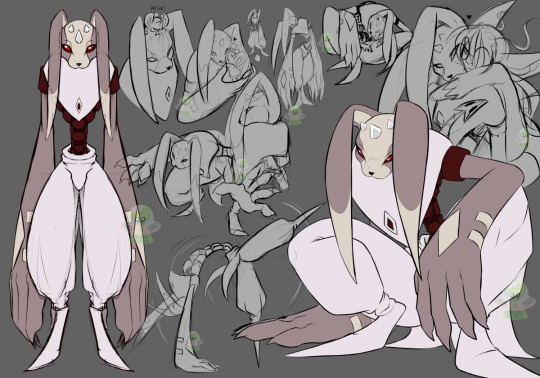
bnnuy
recently remembered Antylamon from the digimon movie and how I had a big ol crush on him even tho he only stayed in this form for like 3 mins lmaoooo and he's also the reason why I'm angry at how we never got another cute rabbit in Pokemon (Lopunny was the only cute rabbit and no cinderace dOESN'T COUNT DON'T @ ME you look at Antylamon and its massive bappers and you tell me Cinderace and compete with it!)
but ye so I'm following in my friend Alfafilly's footsteps and trying to make my own oc of a fic crush so I can gib 'em KISSES u//w//u
I don't wanna stray too far form the og design but I might push it more in future drawings to really make 'em an oc aha WE'LL SEE this is the early stages he'll grow and develop in time also I know next to nothing about Digimon outside of the movie and what few bits I recall from the og series so apologizes for ignoring all lore loool I'm just here for the bnnuy
#rodentscribbles#antylamon#rabbit#I know for a fact my bun is always gonna have his ears dangling in front of his face cause that's the shot in the movie I most recall#also his waist is gonna be SO snatched#I'm unsure what his like chest and spine is meant to be?? like I guess armor but it looks weird af lol#so I might fiddle around with that concept a bit to 1) make it easier for me to draw and 2) make it not look..weird??#I did also remove the pink from the ear tips mostly cause I prefer the palette to be simpler and cohesive#and since I removed the pink form his pants it just makes sense#ANYWAY I'm rambling a bunch lmaooo#digimon#*my characters#*Rodent#*husbun#that's his name til I can figure out a proper one for him lol
38 notes
·
View notes
Text


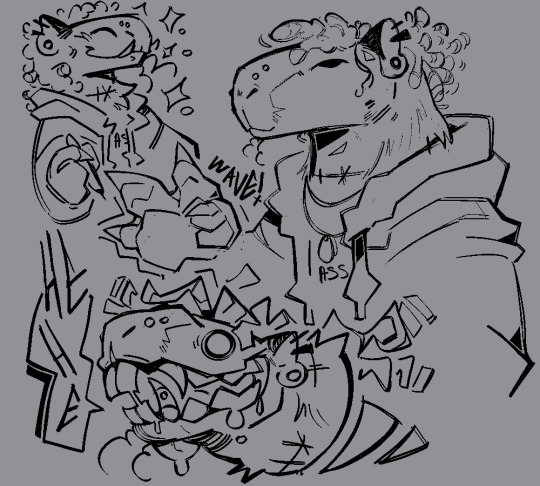
Furred Attempts at One's Self
#my art#my ocs#furry art#furry oc#AKA FURSONAS RAAAAAAHHHHHHHHHH#I've been finally meaning to rip that bandage off and revist my hyena-sona and as you can see there's no time like the present!!#It's actually been a really refreshing and overall happy process so far and I'm happy to share these small bits of it hehe#This all came from the fact I'm getting into the habit of animal studies again and I felt like this would be a nice test of my knowledge#I'm still forever learning but I think I'm on the right path of capturing the face structure of a hyena and in turn other canviorous mammal#My furrysonas are also vessels to give myself bodymods I'm way to scare to get to I just keep winning hehe#Perhaps I'll look just as cool as this...so day#Also fun fact: The reason I choose a capybara as a sona is because I was a capybara in my friend's Cult of the Lamb playthrough hehe#Ever since I've been connected to the large wet rodents; and I wouldn't have it any other way#THAT AND THERE'S BARELY ANY REFERENCES FOR CAPYBARA PAWS HELP ME#I must make them accurate and yet the limits of search engines pain me#That and hyena noses are tricky to understand but I shall digress
43 notes
·
View notes
Text
someone tagged my marbled polecat post as rodent and i am being so calm and normal and not um actually'ing a rando on tumblr. but mustelids are not rodents. weasels and ferrets and polecats etc etc kinda look like rodents! but they are not rodents! big pet peeve of mine as a ferret owner
also fun fact the marbled polecat's scientific name is Vormela peregusna. and vormela comes from a german word meaning "little worm." arent words wonderful. that sure is a little worm!
#mustelids are CARNIVORA. they are CANIFORMS.#they are not rodents!!!!#fun fact the least weasel is the smallest member of carnivora in the world#females can weigh as little as 29g! which is! insane!#and the biggest males only go up to 250#which sounds like a lot comparatively but 250g is one dollar in pennies#vs 29 is roughly 12 pennies#ALSO FUN FACT mustelids are the largest family in carnivora!#they've got a lot going on. from 29g least weasels to 119lb sea otters!#they've got mostly arboreal species! they've got fossorial species! they've got both semi and fully aquatic species!#they have the range#there's around uhhh 70 species i think!#im rambling. BUT THEYRE NOT RODENTS PLEASE KNOW THIS#they're so cool i love them#bel speaks
8 notes
·
View notes
Text
I think Ezra Bridger and Ty Blackthorn would be good friends 😌
#im basing this entirely on ty climbing up a tree with a slingshot taking people down one by one#tell me that isn’t the most ezra bridger move#but seriously though they would LOVE eachother and would definitely think the other is just the coolest#they’re both snarky little shits (affectionate) who love sneaking around and breaking rules they don’t agree with#i know for a fact that ezra would be so psyched to join ty on his little sherlock holmes adventures#they both love their families more than anything in the world and would do whatever it took to save them#they are both scheming little rats who climb in the walls and up trees to get the upper hand#as im writing these tags i am realizing one of the most obvious things of all that they have in common#and i cant believe i didnt think of it earlier#animals!!!#ty and ezra are always the ones to love and care for and respect animals in ways nobody else understands#ty with his rodents and bugs he keeps bringing into his room#and ezra with the loth cats and the wolves and the purrgil#not even just animals but any living being that is being treated unfairly ty and ezra will be there to defend them#ezra would absolutely help ty free the faeries in those cages in the london shadow market#and ty would hands down try to save that wookie baby#also ty would ABSOLUTELY befriend those turtle guys ezra lived with for a decade no doubt about it#star wars#ezra bridger#rebels#ahsoka series#shadowhunters#the shadowhunter chronicles#ty blackthorn#the dark artifices#lady midnight#lord of shadows#queen of air and darkness#kate's post
11 notes
·
View notes
Text
god why are people so uncaring about outdoor cats..... new cat in my neighborhood is like driving my cat insane whenever she looks out the window making it hard for me to take her outside cuz theres always a risk of conflict if they interact but like im the person with the leashed cat whatever whatever but ive seen this cat outside at fucking 1:30 in the morning ive seen him get carried away by someone so clearly hes not a stray but like who the hell cares so little about their cat they dont care that theyre free roaming around a very busy street and dont even worry about getting them in at night when like there have been coyotes spotted in the neighborhood do u care if this animal lives or dies??? and now its out here torturing wildlife outside my window for hours and idk all this is normal??? and like local large animal shelter i go to their website cuz at first i thought this cat was a stray it kept trying to sneak into my house has no collar and is kinda skinny until i saw him get carried away by a person and its like they dont even take friendly stray cats animals that would do quite well in a home they say its best to leave them where they are the way it was nearly impossible to get anyone to go out and even just spay and neuter the stray cats my grandmother feeds which like does fuck all but also they keep having very inbred kinda fucked up looking kittens in the yard every year and sometimes dont even bother to raise the kittens and i feel like maybe it would be best if that stopped whatever its just bonkers to me people think its somehow the normal humane thing to do to just leave unhealthy cats on the streets killing wildlife regularly and getting hit by cars like you would definitely call animal control if a stray dog ripped apart a rabbit in your backyard but this is just how cats are they are tortured if they arent allowed to depopulate local animal populations and like i know animal services have limited resources but idk its just mystifying to me guess im the freak keeping my pampered indoor cat leashed so she can merely chase animals rather than kill them....
#like i dont think these rabbits are endangered but i know for a fact#theres at least one great horned owl that lives a few blocks from my house in an old cemetery#and im sure with the small patches of parks and areas that are suitable for these small mammals#its easily thrown off balance when theres suddenly a new cat killing all the rodents#that owl was gonna eat....#and also its driving me crazy that this stupid cat is making it harder for me to be#the responsible pet owner cuz now i gotta preempt conflict wiht my cat#anytime i wanna take her outside
10 notes
·
View notes
Text
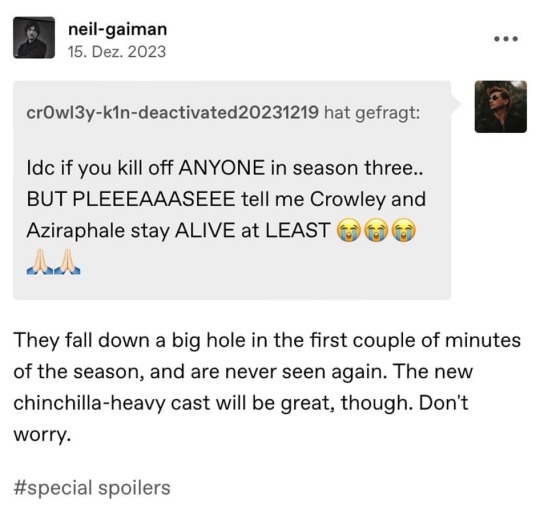
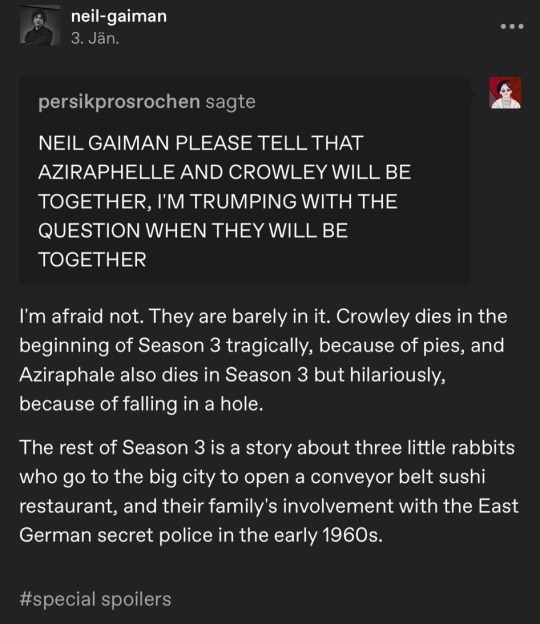
Maybe im reaching but perhaps he’s hinting at a flashback to Crowleys fall… as well as…
…possibly Aziraphales fall?
#big hole sounds to me like pool of burning sulfur#and the fact that hes mentioning it multiple times#im starting to think he isnt just fucking with us but actively dropping hints#also what is it with these rodents he keeps mentioning#i know rabbits aren’t technically rodents but wtf#good omens#go#gomens#good omens s3#good omens season 3#neil gaiman#crowley#aziraphale#aziracrow#ineffable husbands#ineffable divorce#my post
36 notes
·
View notes
Text
the 'beavers being intoduced into england for the first time' news stories are funny bc like, i know it doesn't preclude them already Being in England, but it does casually imply it.
Anyway, Beavers have reintroduced themselves into England and have been there for a good long while now lol
#source: i have seen the beavers#i also did read a couple of the articles and they did neglect to mention their natural spread into england from scotland#i mean i didn't read All the articles so maybe there was better reporting elsewhere but still#anyway. it's 2025. my ideal news stories are in fact related to aquatic rodents.
2 notes
·
View notes
Text
I can't decide if I should be funny and write Cap as a leering Perv possessive kind of guy or stick closer to his personality and have him be a gentleman/chivalrous kind of guy.
#Captain Pikachu#My heart says funny because honestly. Getting eyes from an electric rodent is SO funny to me#Cap who uses the fact that he's small and cute to just casually hang around private spaces#You step out of the shower and he's there with a smirk#dksfjdsjfksdk I dON'T KNOW DON'T ASK ME#But also Cap the kinda guy to use his lighting speed to put Friede's jacket on you after you ran out of your room in your PJs#Oblivious X Chivalrous is a VERY good trope to me I'm thinking like Dojo/Iku from Library Wars style you know??#No of course you don't I'm referencing a manga based on a light novel#Also why the hell is Friede's name spelled like that fuck you. It's Freed dammit.#sdjfhdsjf I've had to google it like seven times I hate it so much why'd they spell it like that#Anyway#I'm thinking of writing a Captain Pikachu X Reader#To sort my thoughts on him a bit better#And I'm trying to figure out what'd just be more fun to write#Reader is a Human btw Cap sees himself equal to the humans around him so I think he'd date a human#Probably another member of the crew#Aaaanyway I'll think on it#And who knooows what'll happen
10 notes
·
View notes
Text
Hey guys my cat brought in a live rodent and mum and I spent most of the morning chasing it around and dismantling most of the kitchen to give it less places to hide, then I opportunistically caught it when it ran out, but then it bit me very hard, and on close inspection the culprit is actually a small rat instead of a large mouse, so now I have to go to the doctor to make sure I don't get diseases 🙃
It's been really fun 🙃
The culprit itself is extremely cute though (and I still think that even though its bites FUCKING HURT)


#draco speaks#this little guy is a hell of a survivor it crawled all the way up our curtains to escape my pets at one point#glad we eventually got them out unharmed but jesus that was an ordeal even before the bites#(also fun fact my dog is terrified of rodents and has been refusing to set foot downstairs)
12 notes
·
View notes
Text
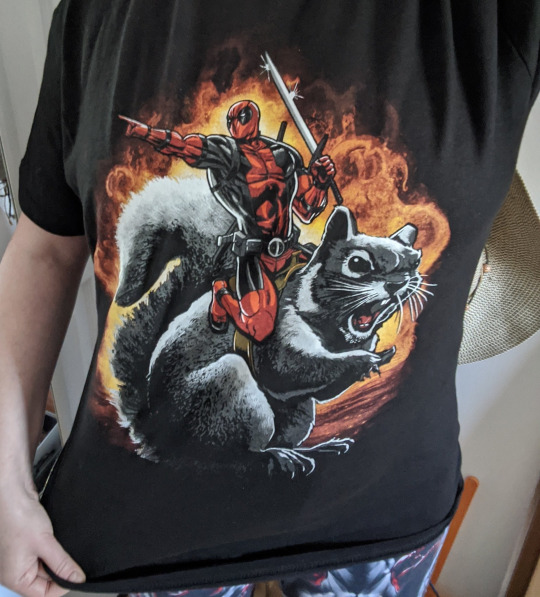
I don't wear a lot of "character shirts," but here's the one Deadpool shirt I couldn't resist. Hits two of my "you know way too much about this topic" interests a little too perfectly (Deadpool and rodents).
...so on that topic, fun fact: gray squirrels can fall from incredible heights without getting hurt. They spread out their limbs and use their tails to orient themselves to increase wind resistance and slow their fall. Combined with their small size, that usually keeps them from hitting velocities too high for them to land safely. They can just drop right out of tall trees and hit the ground running - a super useful adaptation to evade predators.
By comparison: Deadpool can also fall from any height, by getting incredibly hurt then waiting for his healing factor to do it's thing so he can walk it off.
#I am full of random rodent facts they are the coolest little critters#also full of Deadpool trivia because I started reading his comics and can't stop#deadpool#wade wilson#squirrels#rodents
4 notes
·
View notes
Text
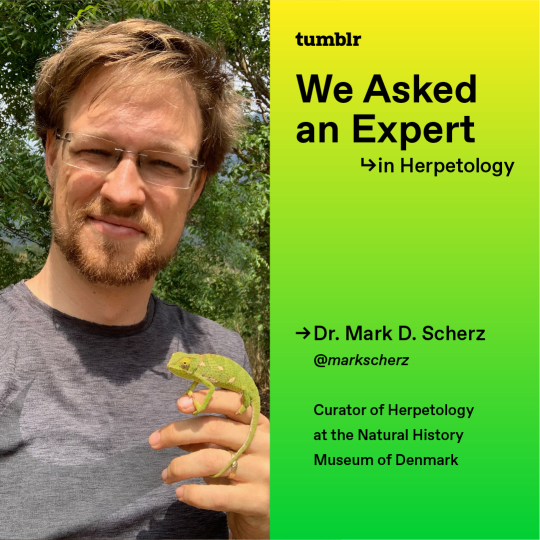
We Asked an Expert...in Herpetology!
People on Tumblr come from all walks of life and all areas of expertise to grace our dashboards with paragraphs and photographs of the things they want to share with the world. Whether it's an artist uploading their speed art, a fanfic writer posting their WIPs, a language expert expounding on the origin of a specific word, or a historian ready to lay down the secrets of Ea-nasir, the hallways of Tumblr are filled with specialists sharing their knowledge with the world. We Asked an Expert is a deep dive into those expert brains on tumblr dot com. Today, we’re talking to Dr. Mark D. Scherz (@markscherz), an expert in Herpetology. Read on for some ribbeting frog facts, including what kind of frog the viral frog bread may be based on.
Reptiles v Amphibians. You have to choose one.
In a battle for my heart, I think amphibians beat out the reptiles. There is just something incredibly good about beholding a nice plump frog.
In a battle to the death, I have to give it to the reptiles—the number of reptiles that eat amphibians far, far outstrips the number of amphibians that eat reptiles.
In terms of ecological importance, I would give it to the amphibians again, though. Okay, reptiles may keep some insects and rodents in check, but many amphibians live a dual life, starting as herbivores and graduating to carnivory after metamorphosis, and as adults they are critical for keeping mosquitos and other pest insects in check.
What is the most recent exciting fact you discovered about herps?
This doesn’t really answer your question, but did you know that tadpole arms usually develop inside the body and later burst through the body wall fully formed? I learned about this as a Master’s student many years ago, but it still blows my mind. What’s curious is that this apparently does not happen in some of the species of frogs that don’t have tadpoles—oh yeah, like a third of all frogs or something don’t have free-living tadpoles; crazy, right? They just develop forelimbs on the outside of the body like all other four-legged beasties. But this has only really been examined in a couple species, so there is just so much we don’t know about development, especially in direct-developing frogs. Like, how the hell does it just… swap from chest-burster to ‘normal’ limb development? Is that the recovery of the ancestral programming, or is it newly generated? When in frog evolution did the chest-burster mode even evolve?
How can people contribute to conservation efforts for their local herps?
You can get involved with your local herpetological societies if they exist—and they probably do, as herpetologists are everywhere. You can upload observations of animals to iNaturalist, where you can get them identified while also contributing to datasets on species distribution and annual activity used by research scientists.
You can see if there are local conservation organizations that are doing any work locally, and if you find they are not, then you can get involved to try to get them started. For example, if you notice areas of particularly frequent roadkill, talking to your local council or national or local conservation organizations can get things like rescue programs or road protectors set up. You should also make sure you travel carefully and responsibly. Carefully wash and disinfect your hiking boots, especially between locations, as you do not want to be carrying chytrid or other nasty infectious diseases across the world, where they can cause population collapses and extinctions.
Here are some recent headlines. Quick question, what the frog is going on in the frog world?
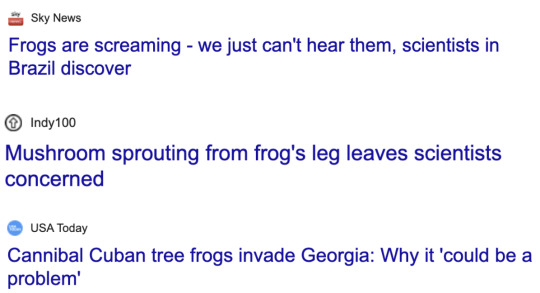
Click through for Mark’s response to these absolutely wild headlines, more about his day-to-day job, his opinion on frog bread, and his favorite Tumblr.
✨D I S C O V E R Y✨
There are more people on Earth than ever before, with the most incredible technology that advances daily at their disposal, and they disperse that knowledge instantly. That means more eyes and ears observing, recording, and sharing than ever before. And so we are making big new discoveries all the time, and are able to document them and reach huge audiences with them.
That being said, these headlines also showcase how bad some media reporting has gotten. The frogs that scream actually scream mostly in the audible range—they just have harmonics that stretch up into ultrasound. So, we can hear them scream, we just can’t hear all of it. Because the harmonics are just multiples of the fundamental, they would anyway only add to the overall ‘quality’ of the sound, not anything different. The mushroom was sprouting from the flank of the frog, and scientists are not really worried about it because this is not how parasitic fungi work, and this is probably a very weird fluke. And finally, the Cuban tree frogs (Osteocephalus septentrionalis) are not really cannibals per se; they are just generalist predators who will just as happily eat a frog as they will a grasshopper, but the frogs they are eating are usually other species. People seem to forget that cannibalism is, by definition, within a species. The fact that they are generalist predators makes them a much bigger problem than if they were cannibals—a cannibal would actually kind of keep itself in check, which would be useful. The press just uses this to get people’s hackles up because Westerners are often equal parts disgusted and fascinated by cannibalism.
What does an average day look like for the curator of herpetology at the Natural History Museum of Denmark?
No two days are the same, and that is one of the joys of the job. I could spend a whole day in meetings, where we might be discussing anything from which budget is going to pay for 1000 magnets to how we could attract big research funding, to what a label is going to say in our new museum exhibits (we are in the process of building a new museum). Equally, I might spend a day accompanying or facilitating a visitor dissecting a crocodile or photographing a hundred snakes. Or it might be divided into one-hour segments that cover a full spectrum: working with one of my students on a project, training volunteers in the collection, hunting down a lizard that someone wants to borrow from the museum, working on one of a dozen research projects of my own, writing funding proposals, or teaching classes. It is a job with a great deal of freedom, which really suits my work style and brain.
Oh yeah, and then every now and then, I get to go to the field and spend anywhere from a couple of weeks to several months tracking down reptiles and amphibians, usually in the rainforest. These are also work days—with work conditions you couldn’t sell to anyone: 18-hour work days, no weekends, no real rest, uncomfortable living conditions, sometimes dangerous locations or working conditions, field kitchen with limited options, and more leeches and other biting beasties than most health and welfare officers would tolerate—but the reward is the opportunity to make new discoveries and observations, collect critical data, and the privilege of getting to be in some of the most beautiful and biodiverse places left on the planet. So, I am humbled by the fact that I have the privilege and opportunity to undertake such expeditions, and grateful for the incredible teams I collaborate with that make all of this work—from the museum to the field—possible.
The Tibetan Blackbird is also known as Turdus maximus. What’s your favorite chortle-inducing scientific name in the world of herpetology?
Among reptiles and amphibians, there aren’t actually that many to choose from, but I must give great credit to my friend Oliver Hawlitschek and his team, who named the snake Lycodryas cococola, which actually means ‘Coco dweller’ in Latin, referring to its occurrence in coconut trees. When we were naming Mini mum, Mini scule, and Mini ature, I was inspired by the incredible list that Mark Isaac has compiled of punning species names, particularly by the extinct parrot Vini vidivici, and the beetles Gelae baen, Gelae belae, Gelae donut, Gelae fish, and Gelae rol. I have known about these since high school, and it has always been my ambition to get a species on this list.
If you were a frog, what frog would you be and why?
I think I would be a Phasmahyla because they’re weird and awkward, long-limbed, and look like they’re wearing glasses. As a 186 cm (6’3) glasses-wearing human with no coordination, they quite resonate with me.
Please rate this frog bread from 1/10. Can you tell us what frog it represents?
With the arms inside the body cavity like that, it can basically only be a brevicipitid rain frog. The roundness of the body fits, too. I’d say probably Breviceps macrops (or should I say Breadviceps?) based on those big eyes. 7/10, a little on the bumpy side and missing a finger and at least one toe.
Please follow Dr. Mark Scherz at @markscherz for even more incredibly educational, entertaining, and meaningful resources in the world of reptiles and amphibians.
2K notes
·
View notes
Text

Splinter mutation speculation! This one is actually pretty old, I drew it before I did all that research on turtles :)
Fun facts about rats: When they are happy, they do a thing called bruxing and boggling, wherein they will grind their teeth together sometimes to the point where the muscles of their jaw make their eyes wiggle in their sockets. They also don’t have paw pads the way dogs or cats do, but instead have little bumps of thicker skin. Look up happy pet rats, they’re absolutely adorable!
These are mostly just my head canons for Splinter as an old jokester with a messed up past trying to do better for the future. We don’t actually see much of him in the show despite dialogue refrencing his daily lessons and his great ‘embarrassing dad’ comedy, so I wanted to speculate of how he might be when the cameras not rolling, per se. It’s tough being the single father of four teenagers without the help of a community, but the brothers are pretty well adjusted (relatively speaking) and are loving towards each other and open to others.
In terms of his anatomy though, while rats may look chubby, it’s in part because of their curved spine and rodent posture. They can get pretty slim when they stretch out. It may be because of these changes to his skeleton that Splinter seemingly shank so much from his human form, while still having the strength to beat people up despite his age. He also made a vow to stop fighting in the Battle Nexus leading to his eventual mutation, which he does break when his kids are on the line, but could be a reason as to why he avoided many of their squabbles in the show? Who knows!
There’s a lot to work with from little characterizations, and it’s fun to see all the different interpretations of his character!
[General][Raph][Donnie][Leo][Mikey]
#rottmnt#rise of the teenage mutant ninja turtles#rise of the tmnt#rise splinter#rottmnt splinter#speculative biology#skeletons#rats are pretty cool animals!#they make great pets and are quite intelligent and loving#they can also grow huge and the idea of what lurks in the New York sewers worries me lol
1K notes
·
View notes
Text

Beavers! I had this one on file now for a couple years, and was waiting until I redid Dovewing's design to post it haha, whoops. I know the journey books are kind of annoying in warriorcats but the Beavers were an addition I found very interesting! A beaver damn can vastly change the landscape of a river system for miles downstream, so the premise is plausible at least, and it was an interesting way to demonstrate the magnitude of Dovewing's powers of perception to perceive things beyond the capabilities of a normal creature of any kind. I don't know where the beavers ended up going, hopefully they're doing well wherever they ended up setting up their new lodge.
Beavers are actually very docile most of the time. Being the largest North American rodent, they have the instincts of a prey species with not many predators that can easily take on a lodge and come away unscathed. Domestic cats in particular would have a pretty tough time defeating beavers, as adult beavers can easily head to head against Lynx and coyotes, sometimes even Cougars if numbers are on their side. They are most vulnerable in the first two years of their life, which will be spent entirely with their birth family lodge where the protection of numbers increases their chance of survival. In terms of size, They are born about the size of a two month old kitten, less than a pound but about a foot long nose to tail, and spend the first couple months inside the lodge where they can play both on dry land and the water inside a safe enclosure. They grow relatively quickly, by the time they are three months old they will weigh close to 4kg or 8 lbs, already a decent size to contend with a small cat, but still very much a baby. By their age of independence at about two, they can weigh upwards of 30 lbs or nearly 14 kg. Beavers also never reach a growth peak, and can become truly massive, upwards of 100lbs/45kg. The fact that the clan cats were able to move beavers with a patrol of 8 cats is a little bit extraordinary, but we will pretend that Lionblaze pulled some super strength and that's why they succeeded haha.
I have here some photos of beavers, on the left is a hunter with a large specimen to demonstrate how big they can get though I don't love or condone hunting haha. In the center I tried to show how different in size adults and offspring can be, and on the right are three different cats near beavers, all of which seem to be quite young, the top one I know for sure from the youtube channel was just a few months old at the time of this image.

#Beavers#Wildlife#warriors#warriorcats#warriorcats designs#warrior cats designs#warrior cat designs#warriorcat designs#warrior cats#warriors designs
400 notes
·
View notes
Note
hey, me again. I finally managed to beat the jorge questline and made quite the realization- the log about the sandwich being stolen and something tracking dust everywhere is most likely actually referring to jorge, considering the context you get it in and the fact that we know jorge is from pre-earth-explosion.
The log in question-
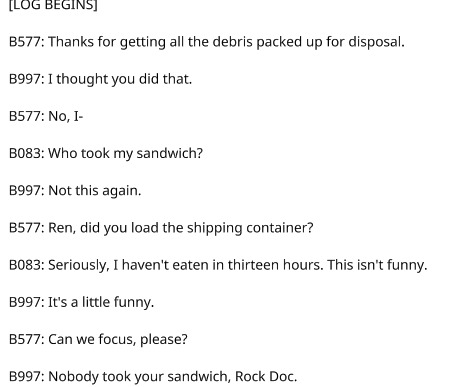

I think this does give some sort of idea as to how big a dupe is, because obviously he'd have to be small enough to not be noticed in his sandwich thievery... ik youve probably combed thru these logs dozens of times by now but as a fellow lore enjoyer i feel like you'd find this interesting
Ive never thought of the idea that dupe Jorge could have been the one stealing the sandwich, that's a cool theory! I personally always assumed it has something to do with one of the previous logs for the hermit story, but looking back on it, it is called a pod entry, which would imply the crashed thing they're extricating resources from was a printing pod related vessel, which means that dupes might have been on board. As such, it would make sense if one of them survived, and was sneaking around stealing food to survive. I had always assumed that B577 was Jorge's doner, explaining Jorge's relevance, but that's actually a rly good point you made and this has helped me understand this log a lot better! I will say though, on the topic of dupe size I tend to be pretty iffy on size speculation given that a lot of ppl tend to ping them as Much smaller than they likely are, as while they're definitely smaller than normal humans they're most likely not like teeny tiny, more likely being roughly half of their donors height based on the very few direct pieces of dialogue we have about duplicant height in relation to human height. I do imagine that a small height likely played a role in his ability to stay hidden, but I think it'd be a rly neat detail if B577 was Jorge's donor and that also contributed to him staying under the radar, with him looking similar enough to get away with being caught at the edge of someone's vision for a moment, especially since he seems to have actually been kind of attached to Ren and Banhi, given the toolbox description and the description of it holding sentimental value to Jorge. Perhaps he was lonely there, and saw the others as friends in a strange way?
Either way this actually lines up a lot more with my initial idea of what his deal probably was, I had thought of him as smth of an escaped dupe who was in hiding before everything went down. Neat stuff!
#rat rambles#oni posting#you see this is why I need to finish that log collection because I hunger for different perspectives on these logs#a lot of ppl tend to misentrepret stuff but well. so do I.#and together we can all account of eachothers misenterpretation or smth like that idk xhdmhdjdh#but yeah the main thing that misinfo gets spread abt is dupe biology and lore#like for example many ppl use the hibiscus log as a point of reference for duplicant height when is most likely isnt abt duplicants#the main two points of note being that both the printed subject and the donor have the same listed size#and just the way that the subjects are described and the fact that theyre both 42cms lol#and also its an olivia log meaning that its almost certainly another rodent since theyre what she mainly works with#olivia does almost certainly know abt and has helped develop duplicants but most likely only in the early days#she isnt directly involved with that specific project anymore likely because she left due to conflict in that project and she just#generally works with animals more so than humans when it comes to bioengineering#now I would say this means she might have not known abt the dna stealing but the dna stealing has been happening since before the printing#pod was even developed as a new way of cloning space colonists#stinky's log taught us that one even if we dont take the scrapped version into account#and given that olivia is the biologist of the two itd be strange if she wasnt directly involved in these early stages of the project#so while Id say she likely doesnt know the complete extent of the duplicant project the dna stealing is still a thing shed likely know abt#anyways that was a tangent appologies for this taking a second to respond
0 notes